- Home
- Encyclopedia
- Yellowstone Ablaze: The Fires of 1988
Yellowstone Ablaze: The Fires of 1988
On June 30, 1988, lightning struck a tree in the Crown Butte region of Yellowstone National Park, in the park’s far northwest corner near where the borders of Idaho, Montana and Wyoming meet. The lightning bolt started a small forest fire, which became known as the Fan Fire. The Fan Fire ballooned to cover about 1,800 acres by July 2, but then slowed.
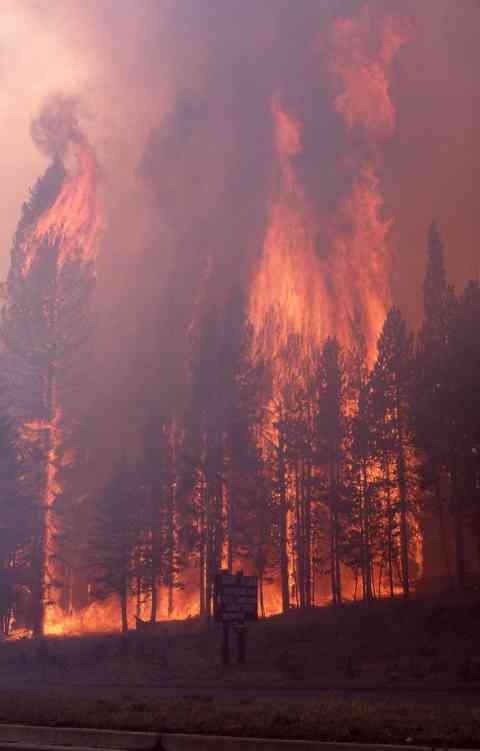
The Fan Fire was the first fire of that summer to erupt within Yellowstone National Park, though the Storm Creek fire had ignited about a week earlier north of the park boundary and would eventually make its way into the park proper.
Park fire experts noted the Fan Fire’s ignition and did … nothing.
Then, in rapid succession over a period of about two weeks, a series of fires broke out across Yellowstone National Park. The largest were named Fan, North Fork, Clover-Mist, Hellroaring, Storm Creek, Mink, Snake and Huck. They grew so large they were no longer fires but “complexes,” according to a 1994 report issued by the U.S. Department of the Interior. During that overheated summer of 1988, they burned about 683,000 of the park’s 2.2 million acres and about 1.2 million acres total within the greater Yellowstone area, which includes several national forests adjoining the park as well as Grand Teton National Park.
Yellowstone’s fire policy
Fire experts originally did nothing to combat the blazes because that was park policy—a policy that surprised a lot of reporters and politicians, including the president of the United States. President Ronald Reagan, roused to comment on the policy, admitted that he hadn’t known about it until September 14, after the fires had been long under way.
The understanding of fire in natural ecosystems had been growing for years prior to the Yellowstone conflagrations, and one of the legislative mandates of Yellowstone National Park is to maintain as nearly as possible “primitive ecological conditions.”
Fire is one of the most basic natural processes. In fact, many plant species within the park are fire-adapted. Some lodgepole pines, which make up about 80 percent of the park’s forests, have cones that are sealed by resin until the intense heat of fire cracks them open and releases the seeds. Fire also stimulates regeneration of sagebrush, aspen and willow.
Since the mid-1970s, park fire policy had been to allow natural fires—started by lightning or other natural causes—to burn. Human-caused fires were extinguished. The park also had an active prescribed burn program to try to reduce fuel loads—fallen trees and dried vegetation—that could contribute to catastrophic burns. In 1975, an environmental assessment was prepared which allowed natural burning on 1.7 million of the park’s 2.2 million acres.
In the years between this assessment and the 1988 fires, the policy was a quiet, uncontroversial success. Tens of thousands of lightning strikes simply fizzled. There were 140 fires, but most burned themselves out after swallowing a few acres. The average burn size was 250 acres. The largest fire during that time was 7,400 acres.
A very dry year
In 1988, as in past years, each fire was evaluated individually to determine how it related to the fire plan. The Fan Fire, for instance, a natural fire, was permitted to burn at first. In the early summer, before the Fan Fire struck, 20 lightning-caused fires had hit the park. Eleven burned themselves out, just like fires in the previous seasons. So park scientists and managers seemed justified in sticking to their fire plan.
But weather conditions in 1988 in Yellowstone Park were taking on a dimension not seen since the park was established in 1872. After a wet spring, the summer months were the driest ever recorded. Still, by July 15, only 8,500 acres had burned in the entire greater Yellowstone ecosystem. But a week later, visitors were noticing the smoke, and the national news media was starting to pay attention to the situation. Dry conditions and high winds were creating perfect conditions for massive fires.
Fires out of control
By July 21, things were spiraling out of control. Park officials decided to try to suppress all new and existing fires as resources allowed. At the time, all the fires in the park covered a total of about 17,000 acres—about 2.5 percent of the area that eventually burned.
In a paper prepared shortly after the fires for the journal Northwest Science, YNP technical writer Paul Schullery writes, “Extreme fire behavior became nearly the order of the day, as fires ran as much as 10 miles in a day, sending embers as much as a mile and a half ahead of the main fire to create dozens of ‘spot fires.’ The presence of so many spot fires, along with the rapid and wide advance of the main fires, made it impossible to fight the fires head-on without risking many lives. Hundreds of miles of fire lines were constructed, but with the spotting behavior fires routinely jumped usual barriers such as rivers and roads.”
“Standard hand- or bulldozer-built lines were no barrier at all,” Schullery continues. “Among the examples of black humor (an appropriate term, if ever there was one) with firefighters was, ‘What's black on both sides and brown in the middle?’ The answer: a bulldozer line in Yellowstone.”
At the peak of firefighting efforts, 9,500 military and civilian firefighters were engaged, using dozens of helicopters and more than 100 fire trucks to try to stop the blazes. Costs passed $120 million. Remarkably, no firefighters died fighting the fires in Yellowstone, though there were two fire-related deaths outside the park.
Students from an elementary school sent trees to firefighters to replace the ones lost. Women of Broadus, Mont., sent them homemade cookies. Chief Ranger Dan Sholly wrote the women a thank-you note: “From the speed with which they disappeared, I know they were appreciated by all of us in the fire camp and on the fireline.”
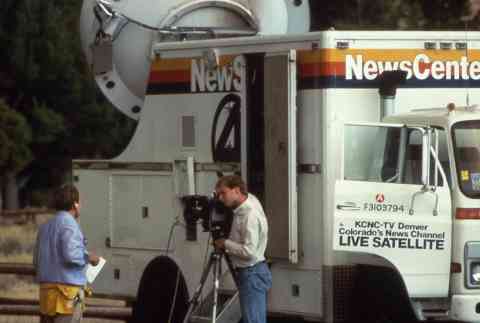
Despite the manpower, the fires continued to grow. A total of 248 fires ignited that summer, but the seven largest caused 95 percent of the damage. On July 5, the Lava fire started; July 11, the Mink and Clover fires; July 22, North Fork fire; July 23, the Clover and Mist fires join; and so on. There were eventually a total of eight fire complexes—depending on who’s counting—with every section of the park aflame.
News coverage
But if the fire line was hot, the descriptive prose was hotter still. Media reporting was often poorly informed and contradictory. The words disaster, devastating and catastrophic appeared often. The New York Times report noted, “stretches of charred, lifeless landscape left by the months of fires.”
Newspapers began covering the story in early July almost as soon as the fires ignited, while national broadcast television coverage came weeks later. The ABC and NBC television networks broadcast their first stories on July 25. CBS broadcast its first story on August 22.
Ohio State University journalism professor Conrad Smith writes in a 1991 paper, “The Yellowstone fires were more newsworthy in the west than in the east. They made the front page of the Los Angeles Times 39 times, starting on July 18 with a news brief about wildfires in the West; the front page of the Washington Post three times, starting on September 8 after the fire’s visit to the Old Faithful Geyser Complex; and the front page of the New York Times three times, starting on September 11 when the secretaries of Interior and Agriculture arrived in Yellowstone for an inspection.”
Both print and broadcast media made some serious mistakes in their coverage. For instance, on July 21, 1988, the park abandoned its “let-burn” policy and began suppressing all fires. But as late as September 1, the New York Times was still reporting that some fires were being allowed to burn. And on September 10, the paper reported on criticism by Wyoming Republican U.S. senators Alan Simpson and Malcolm Wallop of Yellowstone’s natural burn policy, despite the fact that this hadn’t been the policy since mid-July.
But that was nothing compared to an August 30 news story on ABC television featuring an interview with “Stanley Mott, director, National Park Service.” Except that the director of the National Park Service at the time was William Penn Mott, and the ABC interviewee was a tourist.
Local media did better in the assessments of coverage produced by scholars later, especially Montana’s Billings Gazette’s coverage of the economic impact on park-dependent businesses by Robert Ekey, and Wyoming’s Casper Star-Tribune’s coverage of the ecological dynamics by Andrew Melnykovich and Geoff O’Gara.
But the rest of the nation got a different story. Time captured the spirit of the coverage when its editors wrote, “The fires have ruined 1.2 million acres of Yellowstone and adjoining national forests.”
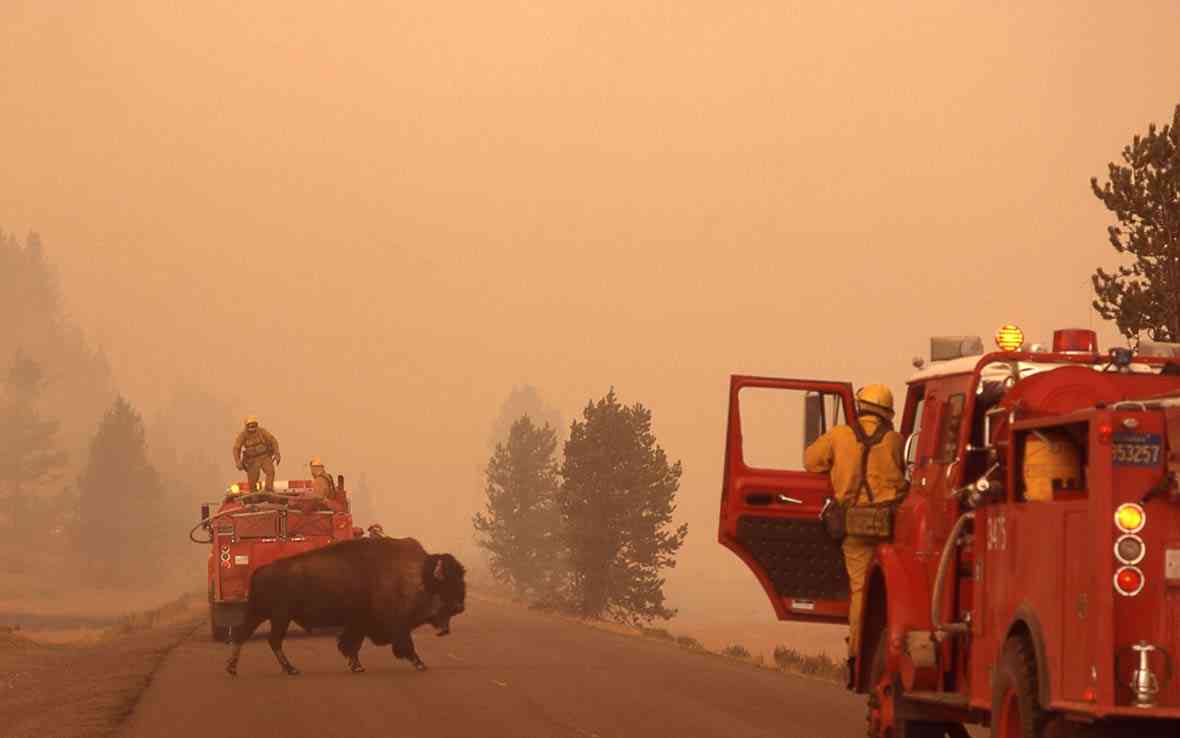
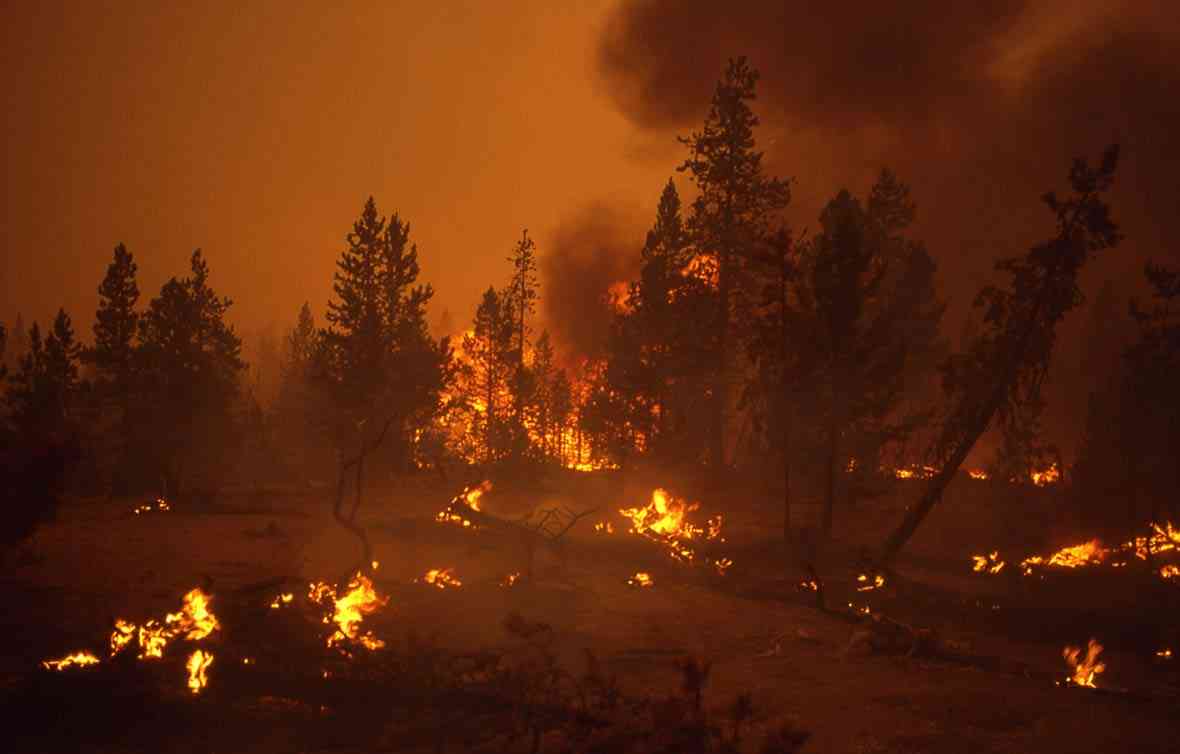
Politics
All this hyperbole quickly worked its way into the political discourse. President Reagan called the park fire policy “cockamamie.”
''It's a disaster,'' U.S. Department of the Interior Secretary Donald P. Hodel told the New York Times as he and U.S. Department of Agriculture Secretary Richard E. Lyng visited the park. ''I think it's devastating, and we've only seen part of it.”
Wyoming’s Sen. Wallop said the park’s 16-year-old “let-burn” policy was “absurd” and scientifically unsound. He joined with Sen. Alan Simpson in calling for the resignation of National Park Service Director Mott. Montana Democratic Sen. John Melcher told The New York Times, “They'll never go back to this policy. From now on the policy will be putting the fire out when they see the flames.”
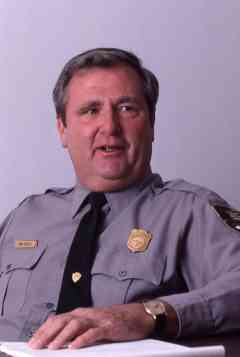
Bob Barbee, then the superintendent of Yellowstone, was cast as the bad guy in the park fire drama. In a 2013 retrospective piece about the fires, Barbee told the New York Times, “It’s like, ‘Well, why don’t you just put it out?’ Well, why don’t you just stop the hurricane or the tornado? You don’t just put it out.”
On Sept. 11, 1988, a quarter-inch of snow fell across the greater Yellowstone area, and the fires quickly died out. Underneath that quarter-inch of snow lay the blackened carcasses of trees, bleached-white, heat-blasted soils—and deep uncertainty about post-fire future of the park. It was accepted wisdom that Yellowstone wouldn’t recover for a hundred years.
Even so, Yellowstone’s big fires were not a surprise to everyone. Paul Schullery wrote in his 1989 Northwest Science article, “Only months before the fires of 1988, a preliminary research report by Dr. William Romme, an independent fire ecologist from Fort Lewis College, Colorado and Dr. Don Despain, NPS plant ecologist, suggested that the Yellowstone area fire regime involved many small fires interspersed every 200-400 years by massive fires that swept across large portions of the park. Romme and Despain concluded that ‘another major burning cycle may begin within the next century, as extensive areas are now developing flammable late successional forests.’”
During the fires themselves, Despain achieved a level of notoriety unusual for a plant ecologist when he showed a Denver Post reporter a fire impact research plot near Ice Lake near Norris Geyser Basin. Environment writer Todd Wilkinson described the incident recently in a Jackson Hole News & Guide column published in April 2015: “The site was established to allow researchers to gauge how fire, drought and disease affect arboreal ecology. As a wildfire approached and swept across his research area, Despain playfully muttered, ‘Burn, baby, burn.’ His quote was included in [the Post’s] story, but a headline writer bannered the words as if Despain were a pyro, not caring if the entire park went up in flames. Wyoming politicians, including U.S. Sens. Malcolm Wallop and Alan K. Simpson, had a field day skewering park officials. Despain was ordered not to talk to reporters for two weeks.”
Recovery
But Despain and the other fire scientists had the last word. The recovery in Yellowstone was a slam dunk for science and the let-burn forest policy.
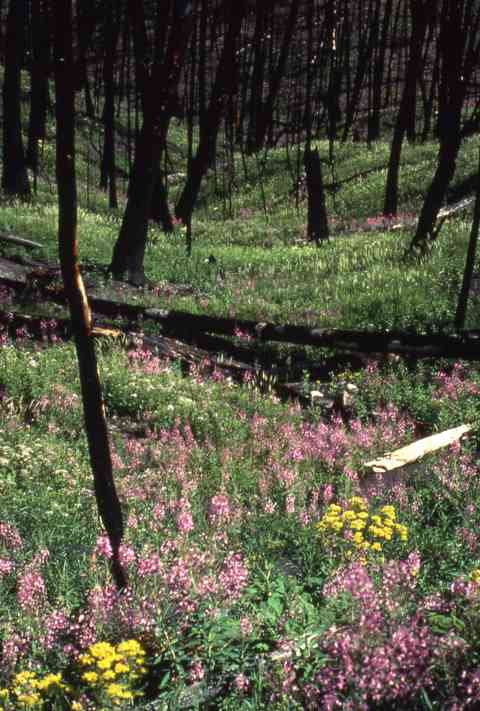
As little as five years after the fires, the park was recovering well. "The forest is going to be re-established. In many cases, the seedling density is greater than the original stand density," said Monica Turner of the Oak Ridge National Laboratory at a 1993 meeting in Jackson held to discuss the implications of the 1988 fire. “In many burned-over areas where mature lodgepole pines once stood,” Turner said, “the number of established seedlings is eight times as large as the original number of trees. Many lodgepole seeds require fire to open.”
The fires also put to rest the Bambi myth—that wildlife flees in panic from approaching flames. At the same 1993 conference, grizzly bear researcher Steve French said, “We didn't see a lot of stress on animals. Bison right in front of the fire line only moved out of the way very casually,” he said.
A survey French conducted of large animal deaths found more than 390 documented deaths from fire, nearly all from smoke inhalation. Of those, 333 were elk, 32 mule deer, 12 moose, nine bison and six black bears. There were no antelope, mountain lion, grizzly bear or bighorn sheep carcasses. With rare exceptions, animals saw the flames coming and simply stepped aside.
University of Wisconsin-Stevens Point professor Mark Boyce said in a talk at the conference that if he were superintendent of Yellowstone, "I would maintain fire every chance I had. I would do my best to eradicate this species”—at this, he showed a slide of Smokey Bear, the patron saint of fire suppression advertisements—“from the park."
Research findings on the ecological impacts of the Yellowstone fires indicate there were very few cases—one-tenth of one percent of the burned area—where high fire temperatures burned deep roots. The impact on park wildlife was minimal. Despite early concerns, white bark pine and aspen came back.
The Yellowstone fires were a watershed in the public understanding of fire’s impact on ecosystems. Wild-land fires have become more easily tolerated except in cases where fires threaten people’s houses and structures--an increasing problem as more people move into the “urban-wild-land interface.” But climate studies indicate that large fires will probably become more frequent around the world. In the Rocky Mountain West, there has already been an increase in the frequency and severity of wild-land fires over the last 25 years, according to a 2008 U.S. Department of the Interior report. A sophisticated, context-sensitive understanding of fire is critical for both safety and ecological reasons. The lessons from Yellowstone in 1988 should inform decisions about this coming whirlwind.
Resources
- National Park Service. The Yellowstone Fires of 1988. 2008, accessed June 24, 2015 at http://www.nps.gov/yell/learn/nature/upload/firesupplement.pdf.
- Romme, W.H. et al. “Twenty Years after the 1988 Yellowstone Fires: Lessons about Disturbance and Ecosystems.” Ecosystems. 2008. U.S. Department of the Interior: 10.1007/s10021-011-9470-6. Accessed June 24, 2015 at http://link.springer.com/article/10.1007/s10021-011-9470-6#page-1.
- Rothermel, Richard C., Roberta A. Hartford and Carolyn H. Chase. Fire Growth Maps for the 1988 Greater Yellowstone Area Fires. 1994. U.S. Forest Service General Technical Report INT-304, accessed June 24, 2015 at http://www.fs.fed.us/rm/pubs_int/int_gtr304.pdf.
- Schullery, Paul. “Yellowstone Fires: A Preliminary Report.” Northwest Science 63, no. 1 (1989): 44-54, accessed June 24, 2015 at https://research.libraries.wsu.edu/xmlui/bitstream/handle/2376/1686/v63%20p44%20Schullery.PDF?sequence=1.
- Smith, Conrad. 1991, Yellowstone Media Myths: Print and Television Coverage of the 1988 Fires. In Fire and the Environment: Ecological and Cultural Perspectives. Proceedings of an International Symposium. Knoxville, Tenn. 1990, accessed June 25, 2015 via http://www.treesearch.fs.fed.us/pubs/2722 at http://www.srs.fs.usda.gov/pubs/gtr/gtr_se069/gtr_se069-section05.pdf.
- Whipple, Dan. “Nature turns massive fire at Yellowstone to its benefit.” Los Angeles Times. Oct.12, 1993, accessed June 22, 2015, at http://articles.latimes.com/1993-10-13/news/mn-45340_1_greater-yellowstone-area.
- Wilkinson, Todd. “Yellowstone fire guru ponders ’88 and now.” Jackson Hole News & Guide. April 1, 2015, accessed June 22, 2015, at http://www.jhnewsandguide.com/opinion/columnists/the_new_west_todd_wilkinson/yellowstone-fire-guru-ponders-and-now/article_2b886c94-6f04-58ea-9eb4-bfc05788a7e6.html.
- Winerup, Michael. “Lessons from the Yellowstone Fires of 1988.” New York Times. Sept. 2, 2013, accessed June 22, 2015, at http://www.nytimes.com/2013/09/02/booming/lessons-from-the-yellowstone-fires-of-1988.html?_r=1.
Illustrations
- The photos are from the National Park Service’s excellent web pages of photos of the 1998 Yellowtone fires. Used with thanks.
